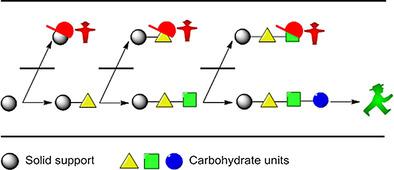当前位置:
X-MOL 学术
›
Chem. Eur. J.
›
论文详情
Our official English website, www.x-mol.net, welcomes your
feedback! (Note: you will need to create a separate account there.)
A Capping Step During Automated Glycan Assembly Enables Access to Complex Glycans in High Yield
Chemistry - A European Journal ( IF 3.9 ) Pub Date : 2018-03-25 , DOI: 10.1002/chem.201801023 Yang Yu 1, 2 , Andrew Kononov 1, 2 , Martina Delbianco 1 , Peter H. Seeberger 1, 2
Chemistry - A European Journal ( IF 3.9 ) Pub Date : 2018-03-25 , DOI: 10.1002/chem.201801023 Yang Yu 1, 2 , Andrew Kononov 1, 2 , Martina Delbianco 1 , Peter H. Seeberger 1, 2
Affiliation

|
The products of multi‐step automated solid phase syntheses are purified after release from the resin. Capping of unreacted nucleophiles is commonplace in automated oligonucleotide synthesis to minimize accumulation of deletion sequences. To date, capping was not used routinely during automated glycan assembly (AGA) since previous capping protocols suffered from long reaction times and conditions incompatible with some protective groups. Here, a method using methanesulfonic acid and acetic anhydride for the fast and quantitative capping of hydroxyl groups that failed to be glycosylated is reported. Commonly used protective groups in AGA are stable under these capping conditions. The introduction of a capping step into the coupling cycle drastically improved overall yields by decreasing side‐products and simplifying purification, while reducing building block consumption. To illustrate the method, the biologically important tetrasaccharide Lc4, as well as a 50‐mer polymannoside were prepared.
中文翻译:

自动化糖浆组装过程中的封盖步骤使获得高产量的复杂糖浆成为可能
从树脂中分离出来后,可以对多步自动固相合成的产物进行纯化。在自动寡核苷酸合成中,未反应的亲核试剂的加帽是常见的,以使缺失序列的积累最小化。迄今为止,由于以前的封端方案受制于较长的反应时间和与某些保护基团不相容的条件,因此在自动聚糖组装(AGA)期间并未常规使用封端剂。在此,报道了使用甲磺酸和乙酸酐对不能被糖基化的羟基进行快速且定量的封端的方法。在这些封端条件下,AGA中常用的保护基团是稳定的。在偶联循环中引入封盖步骤,可以减少副产物并简化纯化,从而大幅提高了总产量,同时减少构建基块的消耗。为了说明该方法,制备了具有生物学重要性的四糖Lc4以及50聚体甘露糖苷。
更新日期:2018-03-25
中文翻译:

自动化糖浆组装过程中的封盖步骤使获得高产量的复杂糖浆成为可能
从树脂中分离出来后,可以对多步自动固相合成的产物进行纯化。在自动寡核苷酸合成中,未反应的亲核试剂的加帽是常见的,以使缺失序列的积累最小化。迄今为止,由于以前的封端方案受制于较长的反应时间和与某些保护基团不相容的条件,因此在自动聚糖组装(AGA)期间并未常规使用封端剂。在此,报道了使用甲磺酸和乙酸酐对不能被糖基化的羟基进行快速且定量的封端的方法。在这些封端条件下,AGA中常用的保护基团是稳定的。在偶联循环中引入封盖步骤,可以减少副产物并简化纯化,从而大幅提高了总产量,同时减少构建基块的消耗。为了说明该方法,制备了具有生物学重要性的四糖Lc4以及50聚体甘露糖苷。











































 京公网安备 11010802027423号
京公网安备 11010802027423号